Indian Food 101: Your Guide to an Indian Restaurant Menu
This Indian food guide is a cheat sheet for Indian restaurant menus. It covers the most popular Indian dishes — what they are, how they’re served & more!
WHY WE CREATED THIS GUIDE TO POPULAR INDIAN FOOD
I love Indian food. All Indian food. However, when I ask people what their favorite Indian dish is, the answer more often than not is “chicken tikka masala.”
This has always bothered me a bit. Now, don’t get me wrong, chicken tikka masala is AMAZING!
In fact, if I had to pick one Indian dish with which to introduce someone to the cuisine, it would probably be chicken tikka masala. But there is so much more to Indian food!
The more I questioned people, the more I found out that it wasn’t that they didn’t like other Indian dishes. They simply felt intimidated by the names and did not understand them. The irony here is that Indian food names are quite simple. The dishes are usually named after the main components or where they come from. But given that fact, if I did not understand the language, I’d be confused too.
Consider this my effort to make things right. Here’s a rundown of what you commonly find on a typical Indian restaurant menu. Now next time when you go to your favorite Indian restaurant to enjoy a meal, use this guide to the most popular Indian dishes and order something outside of your comfort zone. There’s a good chance you’ll be surprised to learn how much goodness you were missing out on!
If you would like to enjoy Indian food at home, take a look at our variety of products, such as our curry sauces — a delicious shortcut way to make amazing curries in just 15 minutes! Purchase online, or find our products in a store near you.
Indian Appetizers
Being the foodie country that India is, there’s a meal planned around every time of the day and food available on every corner. Appetizers served in Indian restaurants are typically popular Indian street foods.
Bhaji: Bhaji (or pakoras) are crispy deep-fried dollops of spicy chickpea batter served with spicy condiments called chutney. Onion bhaji features thinly sliced onions that have been added to the chickpea batter and then deep fried to crispy perfection. Think of it as our version of onion rings! Other popular bhajis are cauliflower, potato, and paneer.
Samosa: Another popular Indian street food is samosa. Samosas contain a small amount of spicy potato or meat filling that is then wrapped in dough and deep-fried until crispy and flaky.
Vada Pav: Vadas are deep-fried fritters or flattened patties of potato, and a pav is just a dinner roll. Vada pav is essentially a spicier vegetarian version of sliders where the fritter or patty is sandwiched between two halves of a dinner roll. Often, condiments are added to the sliders, like onions, green chilies, garlic chutney, and mint and cilantro chutney.
Indian Breads
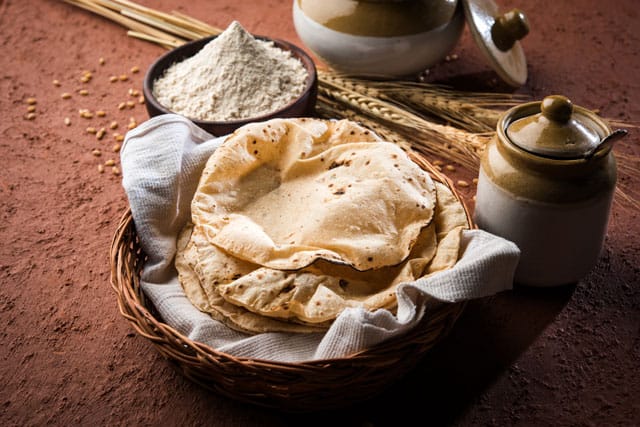
Breads in India are mostly flatbreads. It’s the cooking method or flour base that determines what they’re called.
Naan: Naan is one of the most popular Indian flatbreads. To make naan, wheat flour dough is prepared either by allowing it to rise using yeast or by the addition of yogurt to the dough. That dough is then rolled into flatbreads and cooked in an Indian oven called a tandoor.
Roti: Naan is popular on Indian restaurant menus, but roti is a staple in Indian homes. Roti is a no-fuss Indian bread, typically made with whole wheat flour that’s kneaded into a soft dough, then rolled into thin circles, and cooked on a tava (Indian skillet) on the stovetop.
Paratha: Paratha is a flatbread that is layered and pan-fried. They are made with wheat flour, and ghee or oil is smeared between layers of dough while rolling them. But there are many ways in which you can make a paratha, especially stuffed paratha. In a stuffed paratha, the filling is stuffed into a ball of dough and then rolled into a flatbread.
- Aloo Paratha: With spicy potato filling
- Gobi Paratha: With spicy cauliflower filling
- Vegetable Paratha: With a variety of vegetables stuffed
Poori: Poori is flat circles of dough that have been deep fried in ghee or oil until they puff and become slightly crispy on the outside. Typically served with aloo ki sabzi (curried potatoes) or chana masala (curried chickpeas), this is a beloved comfort food in northern India.
Indian Meals
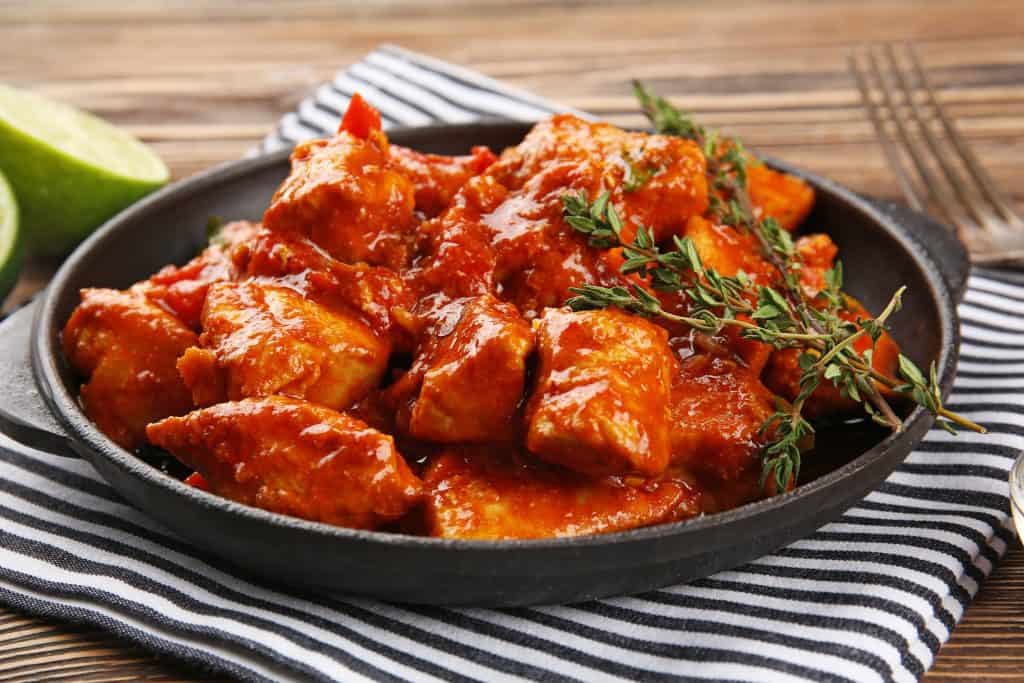
-
Tikka Masala: Tikka is the Hindi term for “small chunks,” and masala means a spice blend. So when small chunks of chicken are cooked in a sauce with a particular spice blend, it is called chicken tikka masala. When paneer comes to the play, it is called paneer tikka masala. The world-famous sauce used in tikka masala is mainly tomato-based, with some richness added by cream or thick yogurt.
Chana (Chole) Masala: Chana or Chole is the Hindi name for chickpeas. Chana masala is simply chickpeas cooked in an onion, ginger, and garlic-based sauce with garam masala added to it. This is a popular North Indian curry; it’s spicy and packs a punch. It’s typically served with soft and flaky bread called bhature, or with a baked, pillowy bread called kulcha.
Saag Paneer: Saag is simply the Hindi name for leafy green vegetables like spinach, collard greens, mustard greens, and more. But this particular dish refers to a delicious curry where spinach is cooked with spices, and then diced paneer (an Indian cheese) is added to the dish. At some Indian restaurants, you can also find this dish under the name of palak paneer, where palak is the Hindi word for spinach.
Korma: Korma is a nutty, creamy curry often made with crushed cashews or almonds. In most korma dishes, protein is cooked with a yogurt-based sauce flavored with ginger and garlic. Fried onion is added to thicken the sauce and also gives it a hint of sweetness.
- Navratan Korma (Navratan translates to “nine,” so this dish is made with nine different types of vegetables, dried fruits, nuts, and sometimes paneer.)
- Chicken Korma
- Vegetable Korma (vegetarian)
- Roasted Pumpkin Korma
Rogan Josh: This dish hails from the beautiful northern state of India, Kashmir. With its roots in Persian cuisine, this dish is traditionally cooked with lamb or goat. Rogan josh consists of pieces of lamb or mutton braised with a gravy flavored with garlic, ginger, and aromatic spices (cloves, bay leaves, cardamom, and cinnamon), and some versions incorporate onions or yogurt.
- Mutton Roganjosh or Goat Roganjosh
Vindaloo: When the Portuguese came to India and established their colony in Goa, they also brought with them their cuisine. And when that Portuguese food married with Indian flavors, several good things happened. Vindaloo curry is one of the products of that. Fiery and flavorful, vindaloo is traditionally made with pork marinated in wine vinegar and garlic.
- Pork Vindaloo
- Chicken Vindaloo
- Lamb Vindaloo
- Shrimp or Fish Vindaloo
Dal: Dal is the Hindi name for lentils, and it broadly refers to all lentil soups in Indian cuisine. Typically, the lentils are pressure-cooked with water and then mixed with onions, tomatoes, and a variety of spices (ginger, garlic, turmeric) to give more flavor to the dish.
- Dal Makhni: 2-3 varieties of lentils/beans cooked with spices and cream or butter added for richness. Makhni refers to the use of makhan (butter) or cream.
- Tadka: Dal with a mild tempering of whole spices like cumin seeds, mustard seeds, etc.
- Chana Dal: light and zesty Split Bengal lentil soup; this dish is much lighter than dal mahkni.
- Dhaba Style Dal: Dhaba are roadside food joints by the freeways in India. The food served there is pretty popular because it is homestyle cooking, but with an extra amount of butter or cream! It’s so delicious and popular that the dal served in those dhabas somehow made their way into more upscale Indian restaurants.
Biryani: A very popular Indian rice dish with its roots in the Mughal empire in India, biryani is a rice dish prepared with several layers of rice, some kind of spiced meat, paneer or vegetables, and some added richness with ghee or yogurt, and then finally slow cooked to perfection. It is topped with caramelized onions and saffron for a rich taste. There are a variety of options when it comes to biryani:
- Chicken Biryani
- Hyderabadi Dum Biryani (this tends to be one of the spicy varieties and usually uses chicken)
- Goat Biryani
- Lamb Biryani
- Shrimp Biryani
- Paneer Biryani or Vegetable Biryani
Aloo gobi: A widely loved Indian vegetarian dish made up of spiced cauliflower and potatoes. This is a dish people often make at home because it is easy to make, and the combination of cauliflower and potatoes makes it a very filling entreé.
Indian Drinks
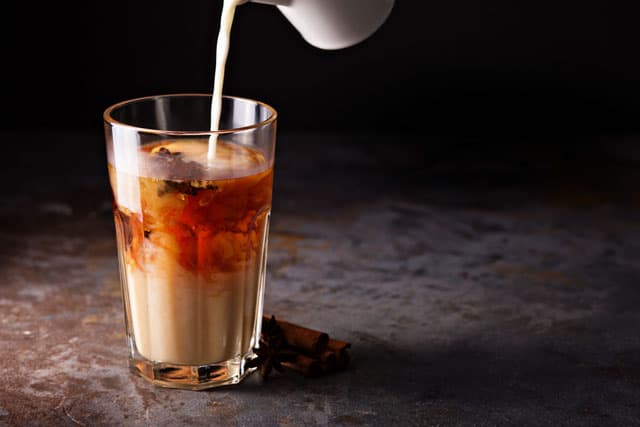
Chai (Tea): The Indian name for tea is chai. Chai is made by boiling black tea in water, then adding milk and sugar and bringing to a boil again before straining and serving. And yes, when you order a “Chai Tea Latte” at Starbucks, you’re ordering a “Tea Tea Latte.”
Masala Chai: This is when you add some kind of spice (masala) to the concoction above, and that makes it masala chai. Typical masala chai has a blend of cardamom, cinnamon, cloves, and ginger cooked in chai. While it’s regularly shortened to “chai” in cafés and coffee shops around the globe, masala chai is actually the beverage that many non-Indians have fallen in love with.
Lassi: A sweet yogurt drink traditionally made by thinning out yogurt with milk or water and then sweetening it for more flavor. Cream is added to the drink too to make it richer. Lassi can be made into different flavors simply by adding various fruits, additional flavorings, etc. For example, mango lassi is made by mixing mango and yogurt, whereas strawberry lassi contains fresh strawberries, etc.
Chas: Savory yogurt drink, similar to lassi though slightly thinner. Chas is infused with cumin, mint, and rock salt acids. It’s best enjoyed after a heavy meal to help with digestion.
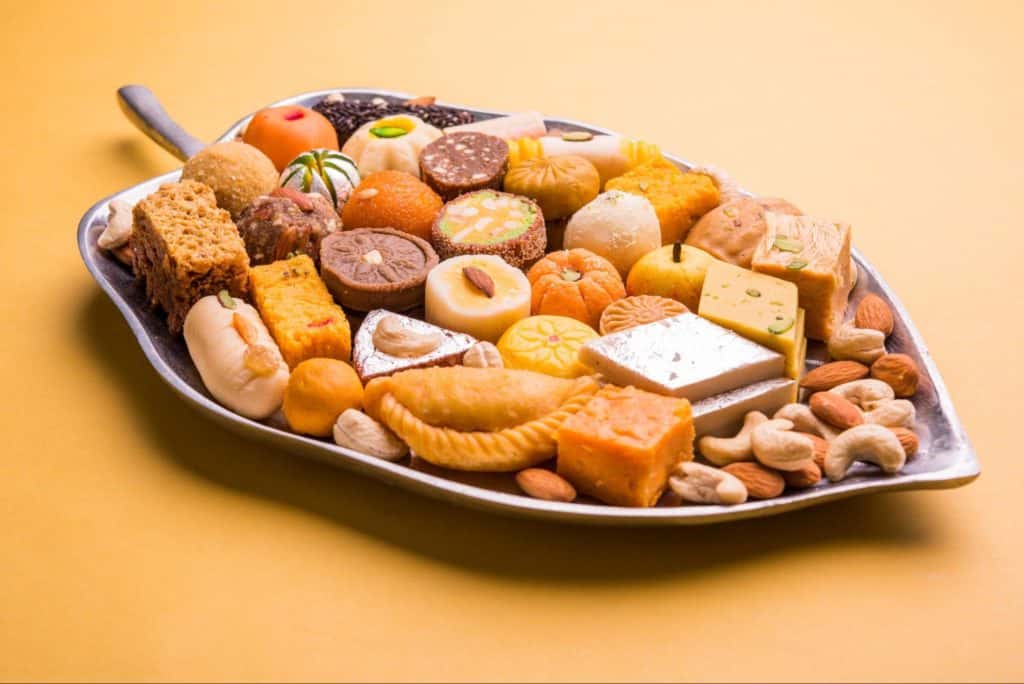
Indian Desserts
Gulab Jamun: If chicken tikka masala (or some might say butter chicken ) is the king of Indian curries, then gulab jamun is definitely the king of desserts. Milk powder and wheat flour are kneaded with milk to form a smooth dough. The dough is then rolled into small balls, deep fried, and dunked into sugar syrup until the balls absorb the syrup and become soft and juicy.
Halwa: Halwa is a pudding made with any variety of flour — like chickpea flour, wheat flour, semolina, or root vegetables — that’s cooked with sugar, ghee, and water/milk.
- Gajar Halwa: Carrot pudding, made by cooking freshly grated carrots along with sugar, milk, and ghee.
- Besan Halwa: Besan is the Hindi name for chickpea flour. This pudding is made by cooking chickpea flour in rich sugar syrup.
- Mung Halwa: Made with mung bean flour.
Barfi: Barfi has a fudge-like texture made from condensing milk with ghee and sugar, and it is flavored with nuts or spices like cardamom or saffron. In this dish, a sweet batter is thickened and then set to cool and cut into smaller pieces. There are many different varieties of barfi (also called mithai), with the dessert varying widely from region to region.
- Kaju Ki Barfi (Kaju Kathli): Kaju is the Hindi name for cashews. So this Kaju barfi is made with a sweet cashew paste.
- Besan Barfi: Made with gram (chickpea) flour.
- Coconut Barfi: Made with shredded or finely ground coconut.
- Almond Barfi: Made with almonds.
- Pista Barfi: Made with pistachios
Doodh Peda: Doodh is milk, and peda is a circular barfi. To make doodh peda, sweet milk is thickened and flavored with spices like cardamom or saffron, and then small portions are rolled into small discs.
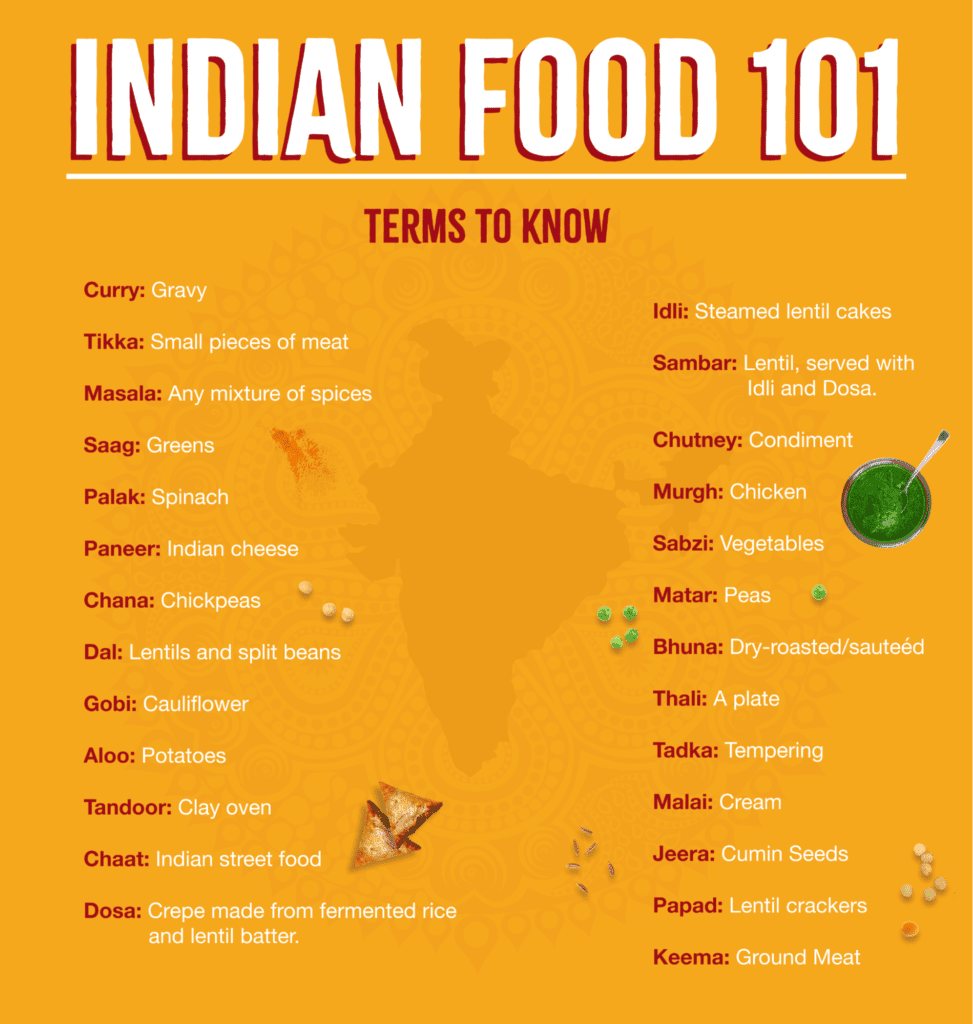
Other Indian Food Terms to Know
Curry: Often confused with the term “curry powder,” the word curry just means gravy. There is no flavor associated with “curry,” but traditional Indian curries have very little in common with the Curry Chicken Salad at your local grocery store.
Tikka: Small pieces or cutlets of chicken/meat.
Masala: Any mixture of spices. One of the most common is “garam masala,” which translates to warm or hot. These are the spices that make the body warm.
Saag: Greens. Most often spinach, but can also be mustard or other greens. “Palak” is specifically spinach.
Paneer: Indian Cheese. The only cheese used in Indian Cooking.
Chana: Chickpeas.
Dal: Lentils and split beans.
Gobi: Cauliflower.
Aloo: Potatoes.
Matar: Peas.
Tandoor: Clay oven. Anything that comes out of the clay oven will usually be preceded by tandoori. (tandoori naan, tandoori dish, tandoori chicken, etc. )
Chaat: The all-inclusive word for Indian Street Food.
Dosa: South Indian crepe made from fermented rice and lentil batter.
Idli: Steamed lentil cakes made from fermented rice and lentil batter.
Sambar: South Indian Lentil, served with Idli and Dosa.
Chutney: Condiment. Most people are familiar with fruit chutneys, like mango, but some of the best chutneys are herb-based, like cilantro and mint.
Murgh: Chicken
Sabzi: Vegetables
Matar: Peas
Bhuna: dry-roasted or sauteéd
Thali: Literally means a plate, but in the context of Indian cuisine, it mainly refers to a way of serving food. Several dishes are served on the same plate, and you essentially start with an appetizer and finish off with a dessert or a cooling drink.
Tadka: Tempering
Malai: Cream
Jeera: Cumin Seeds
Papad: Lentil crackers
Keema: Ground Meat
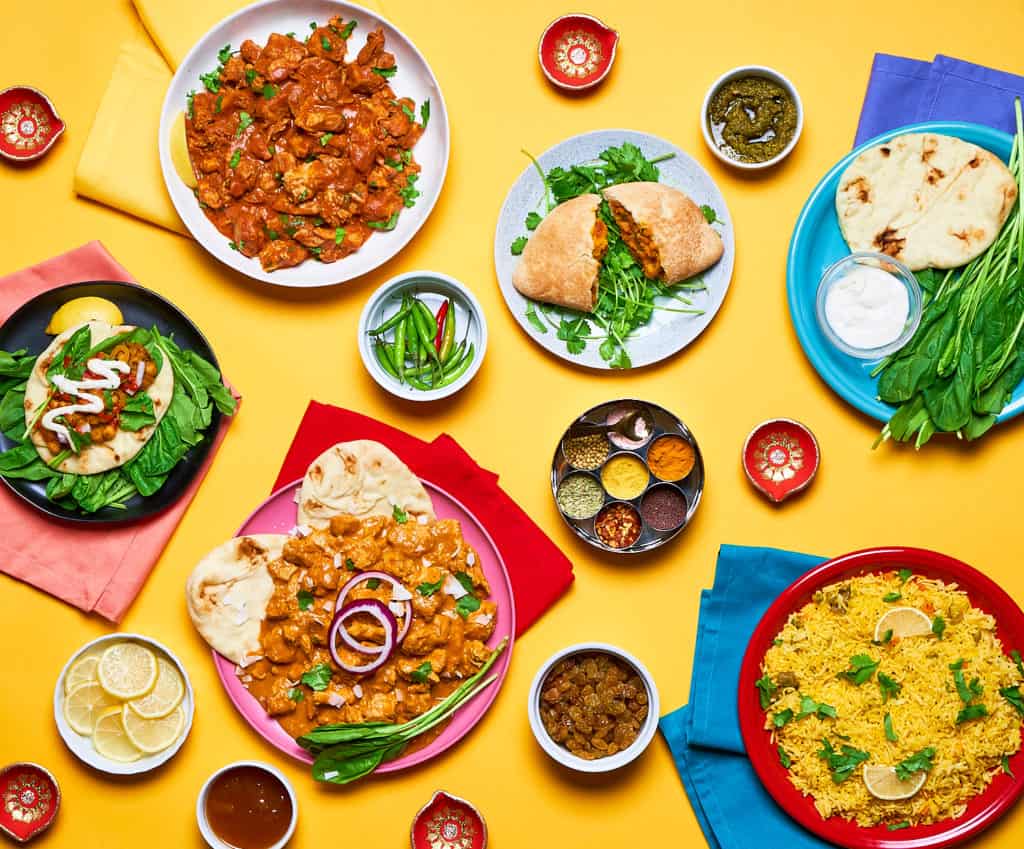
Learn All About Food In India With Sukhi’s
Learning more about Indian cuisine isn’t a one-time crash course — it’s a lifelong education.
Fortunately, you don’t have to bury your nose in a book. Instead, your “classes” can include visiting your local Indian restaurants and browsing our extensive entreés, naanwiches, sauces, and so much more!
To dive deeper into the world of Indian food, browse our blog to learn more about the different types of curry and the difference between North and South Indian cuisine.
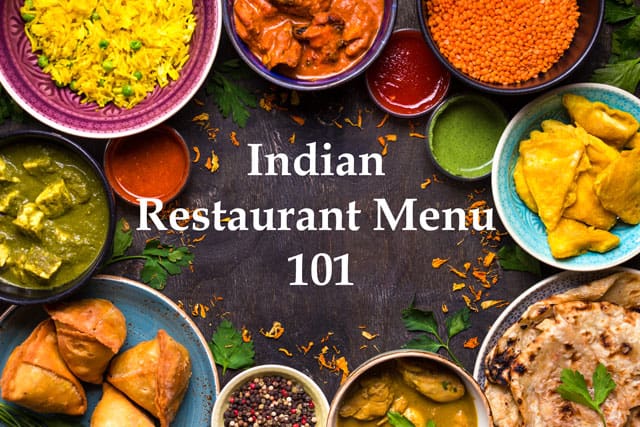

85 responses to Indian Food 101: Your Guide to an Indian Restaurant Menu
Very informative article, thanks!
Wonderful informative article, thanks!
Amazing article. It’s a great resource for those wanting to learn more about this amazing cuisine and culture. Thank you.
Please tell us about pappadam.
It is mentioned as Papad above.
Thanks this was very helpful !
Very informative. Would have liked it presented with visuals of the dishes
Thank you – a wonderful education about Indian food. Very thoughtful to share.
I love your food and would like to see any updates regarding where your dishes can be found.
This is a great little cheat sheet for the Honorary Desis/Indians in my life. Thanks Dalbir!
This guide is great! I’m saving it for future reference. Thank you.
Thanks Jane!
Thanks Maryanne!
There’s a good chance you can find our products at a store very close to you 🙂
If you just click on “Store Locator” on the top right of this page, and type in your zipcode, you should see a whole list of products available at stores around you.
Putting that on our “to-do” Roger! Thanks for the suggestion.
Hai, I am happy to found this blog! Great information you are sharing about Indian foods. Here I learn a lot of Indian food varieties and explanations. Thanks for sharing this blog!
Worth reading!
Thanks for the information , my wife and family are from India and they all pronounce the food a little differently , this helps me out where it’s spelled out, peace & love
Fantastic article! I love “Indian” food, but haven’t really figured out the “structure” of the cuisine. This is very helpful . One question: what is Mithai?
I’ve alway’s loved Sukhi’s chutneys, and have at least 3 varieties in the fridge.
I used to get your Vindaloo paste – it was my secret ingredient in my deviled eggs.
Thank you!
Thanks for your feedback Ellen! Mithai is just a hindi name for Indian desserts.
Vindaloo paste in deviled eggs? Sounds like a killer idea!
Aloha to Those that sent me a reply to my text msg.
Thank-you once again for the case 101.
If you ever decide to open a cooking class in Honolulu, I would like to sign-up as a student.
Will you be offering more selections at Costco ?
Mahalo nui loa (thank-you very much).
Randall Lau
[…] Indian Food 101: Your Guide to an Indian Restaurant Menu […]
Thanks for the guide to an Indian restaurant menu. I love Indian food, and I am trying to find some good restaurants near me that offer it. I am still trying to work my way up to having the spiciest dish, but I’m getting there.
we enjoy what you guys have posted here. don’t stop the super work!
I’ve always wanted to try Pakoras since that’s one of the Indian foods that I haven’t tasted before. Thanks for mentioning my favorite bread Roti which I’ll definitely order for take out in case I find a good restaurant to order from. I think I might try some Korma as well so that I can have some varied spices in my food that I haven’t tried yet.
[…] Indian Food 101: Your Guide to an Indian Restaurant Menu […]
What?! No ladoo on this list? LOL it’s my favorite Indian dessert. This is a great list with lots of info!
Great list. Very informative. It will be even better if you could include more photos.
Thanks for the feedback. We will try to update the post with more photos.
Are all your dishes halal?
Very informative article. Any one from any walk of life with different culture, language and ethnic can understand and quite relate to the materials explained in this article. Thanks
Thanks for sharing this useful information on diverse Indian food.
Thanks for taking the time and giving it a read! 🙂
Thanks for sharing a valuable article with us, because I am tired to decide the menu items, here I get all answer. Is designing also effect?
Thank you so much for this article. This is a really helpful intro.
Very informative!
Thanks Tripti!
Nice Blog! It’s very informative Content!
Thank you for this article of Indian Food 101. I have loved Indian food for 50 years, my husband was Indian, and we would have the best family reunions when his brothers would come to the US from India for a visit. I have been to India twice in the last six years to visit my husband’s relatives. I absolutely love them!! I have quite a nice collection of Indian spices and my daughter and I enjoy cooking Indian. My choice changes now and then. Now, I enjoy ordering Lamb Karma. Love it!! We have three very good Indian restaurants in our area of the Puget Sound in Washington. Your products are sold at our local Trader Joe’s, which is so handy.
Thank you for your interesting articles and recipes.
We are learning to to prepare indian food and this is so helpful. Thank you!
This is wonderful! Thank you for your content!
Thanks for visiting us and dropping a comment.
Thanks for your Information.
Great post about Indian Food . I really appreciate your efforts put on this blog. Thanks for sharing this
Indian food has such a flavorful taste. I enjoy reading about these traditional recipes. Thank you for sharing with me.
Thanks for sharing this amazing post.
nice post
Hey ,
Thanks for Indian food blogs , It is so delicious and good to read the menus . I enjoyed
cool
Thanks for sharing such an informative and awesome blog. Really it will help in great manner to know about Indian Foods.
Great Post!!
Thanks for sharing this post here with us.
Could you please add more info about sambar to the list. Also do you know about Masala shikanji (unsure if I am writing it right), and info about the salted lassi? And jalebi and ladoo. I llove Indian food too, and I am trying North Indian as well as South Indian foods.
I have always loved Indian food. But due to the distance of the country, it is not eaten much. After this i came to know about many recipes. Of course I will try to make at home and try to feel delicious taste. Thanks for sharing a valuable article and I enjoy it.
Thanks for the guide to an Indian restaurant menu. I love Indian food, and I am trying to find some good restaurants near me that offer it. I am still trying to work my way up to having the spiciest dish, but I’m getting there. I have also read another blog about indian food
And i have tried this samosa and its good. Thank you for the blog, Going to try another one!
please enter the White Rotti and Chapati is also Indian food
thanks for sharing this post here with us, really it will help in great manner to know about indian foods
amazing article and valuable information on this website i wil totally recomment this website to my friends and family & also check out my blog page which is recently started and keep supporting
Thanks, Rehan! Appreciate you sharing our site and food with your friends and family.
Great blog just loved the way you tell about the best things. Even though I have already read some of the blogs. Thanks for it once again.
Hello, after reading this awesome piece of writing i am too delighted to share my knowledge here with mates.
Woah! I’m really enjoying the template/theme of this
site. It’s simple, yet effective. A lot of times it’s hard to
get that “perfect balance” between user friendliness and appearance.
I must say you have done a great job with this.
Additionally, the blog loads very quick for me on Firefox.
Say, you got a nice blog post.Thanks Again. Keep writing.
Hello there!!! It was wonderful to go through your blog. It is full of information and adds great values to the readers. This kind of blog helps readers like us in many ways and increases our interests. Thank you for sharing and looking forward to reading more of your blogs.
I just met an Indian friend yesterday and we just immediately got along nicely. It’s interesting to learn more about their food and how a rice dish called Biryani is traditionally cooked with ghee or yogurt. It would be nice to find a meal delivery service that has this meal so we can compare how it tastes like.
Biryani – without anything in front of it, is just rice?
Dhaba Style Dal – what is different about it?
Curry – most definitely has a distinct flavor… is a sauce unless you add the word powder… includes turmeric, cumin, ginger, black pepper sometimes with garlic and cinnamon, can be spicy or mild
Vandaloo – should indicate it is a very spicy sauce and how is it cooked? Fried? Baked? Broiles? Stewed?
Saag Paneer – important to indicate cheese
Glossary – alphabetize or what order is this in?
Thank you for your feedback, Jen! I have gone ahead and clarified some of the terms that you mentioned. Hopefully it makes more sense now! Let us know if you have tried any of these dishes at an Indian restaurant before.
We’ve noticed that our local Indian restaurant has some dishes that are all meat and no sauce (flavorful because of the seasoning, but very dry), and other dishes that are basically a small amount of meat just swimming in sauce (even when accompanied by copious amounts of rice). Is this common? Are we supposed to combine dishes of each style or something? The contrast is leaving us wondering if we’re lacking some basic tenets of Indian dining.
Hi Brian, This is a great question. Meat dishes do vary in style. Some may be more dry or even grilled, such as Tandoori chicken or kebabs which are minced meat patties or minced meat cooked on skewers. The ones with a sauce are different style of curry. We would recommend trying both and seeing what you like. Often the drier meats are eaten more as starters/appetizers with chutneys and the curries are eaten with rice or naan (or other flatbreads) as the main meal. Hope this helps! Keep exploring the menu and see what you like best.
It was helpful when you explained the importance of greeting the guests at a restaurant as soon as they come through the front door. In my opinion, it would also be beneficial to invest in faux wood or leather covers for the menus to give diners the impression of professionalism from the moment they’re seated. The info you discussed here will be helpful to anyone looking to open a restaurant, so thanks for taking the time to share!
Thanks, mam from the bottom of my heart. This post will enhance my knowledge. As I have my own recipe for korma. But from this post korma’s taste has improved.
Give me a favor mam. Please post more blogs about Indian food.
hey Prerna mam , wonderful and helpful post. I just loved it. I like Indian food very much and loved the way your writing style. Thanks , from the core of my heart, for sharing such a lovely post.
Thanks Angela! So glad you enjoyed the post. Hope you get to enjoy some of these favorite Indian dishes soon.
Who said bhuna means fried???
Its saute’. Can elaborate more if required.
whereas frying is totally a different approach where it is done shallow or deep. Hope i got it right.
Thank you for your feedback!”Bhuna” originated from the Urdu word for “fried”. It describes the process of frying spices and ingredients like onions, ginger, and garlic in hot oil until it forms a paste. We will be sure to update the description with a better explanation.
Very well written and very informative article for all foodies!!
I appreciated your sharing the different Indian cuisines we can choose from. I couldn’t imagine that we could choose from plenty of menus. The sumptuous cuisine, from the main course to desserts and drinks, gave me an idea of what to choose. My officemates love Indian food and planning to have a food festival party. These Indian foods will be a good selection.
The menu is the One Document that decides a restaurant’s success or failure.
So spend the majority of time planning and executing a menu that suits your market and pocket.
This article is written so well and much useful and informative. Thanks for giving such wonderful informative information. I hope you will publish again such type of post.
Your blog made me hungry! So well explained
I wanna open my own restaurant and these food menu will be a good selection for my restaurant because the menu of a restaurant decides a restaurant’s success /failure. Thanks and i hope you will publish such article again.
[…] Eating Indian food on the go just got a whole lot easier! Today, we’re walking you through making Chicken Vindaloo Wraps. Chicken Vindaloo is an Indian dish made up of chicken, dried chilies, ginger, garlic, and vinegar! It’s a spicier curry and is delicious with chicken, tofu, or veggies. […]
Nice blog, enjoyed reading the article. Thanks for it 🙂
Indian food is the best food near me.
Indian food is the best food in the world.